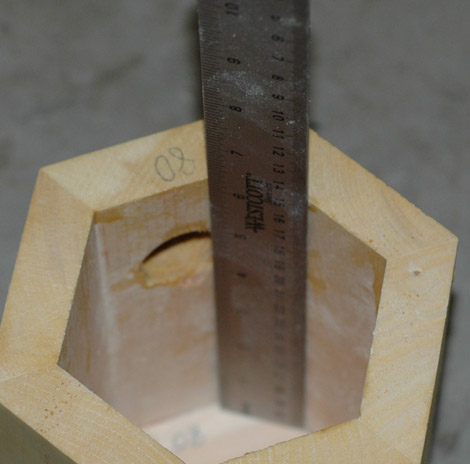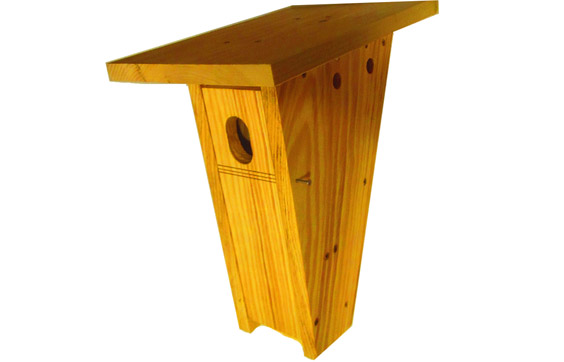
Measurements For Different Bird Species
|
A birdhouse should be built with a particular kind of bird in mind. Most birds will prefer houses that have one compartment with a single entrance. Refer to the table below for recommended dimensions for attracting specific cavity dwellers. Each column subject is explained in detail below. Since construction and woodworking measurements are still generally in inches, the table below has been completed using imperial inches.
|
Birdhouse Measurements for North American Birds |
Scientific Name |
Common Name |
Entrance Hole |
Floor Size |
Distance from Floor to Entrance Hole |
Height Above Ground (feet) |
| Aegolius acadicus |
Saw Whet Owl |
2.5 |
7 x 7 |
14 - 15 |
12 - 20 |
| Aix sponsa |
Wood Duck |
4 |
10 x 19 |
12 - 16 |
7 - 20 |
| Baeolophus bicolor |
Tuffed Titmouse |
1.24 |
4 x 4 |
6 - 10 |
5 - 15 |
| Bucephala albeola |
Bufflehead Duck |
4 |
10 x 18 |
16 - 18 |
10 - 20 |
| Bucephala islandica |
Barrow's Goldeneye Duck |
3 |
8 x 8 |
9 - 12 |
10 - 30 |
| Carpodacus mexicanus |
House Finch |
2 |
6 x 6 |
6 - 8 |
8 - 12 |
| Certhia americana |
Brown Creeper |
1.375 |
4 x 4 |
6 - 8 |
4 - 10 |
| Colaptes auratus |
Northern Flicker |
2.5 |
7 x 7 |
14 - 16 |
6 - 20 |
| Dryocopus pileatus |
Pileated Woodpecker |
3.5 |
8 x 8 |
12 - 20 |
15 - 25 |
| Falco tinnunculus |
Kestrel |
3 |
8 x 8 |
9 - 12 |
10 - 30 |
| Glaucidium brasilianum |
Pygmy Owl |
2.5 |
7 x 7 |
14 - 16 |
12 - 18 |
| Hirundo rustica |
Swallow |
2 |
7 x 7 |
14 - 16 |
12 - 18 |
| Megascops kennicottii |
Screech Owl |
2.5 |
7 x 7 |
14 - 15 |
12 - 50 |
| Melanerpes carolinus |
Red-Bellied Woodpecker |
2.5 |
6 x 6 |
9 - 12 |
10-20 |
| Melanerpes erythroceph |
Red-Headed Woodpecker |
2 |
6 x 6 |
9 - 12 |
10 - 20 |
| Melanerpes lewis |
Lewis Woodpecker |
2.5 |
7 x 7 |
14 - 16 |
12 - 20 |
| Myiarchus crinitus |
Crested Flycatcher |
1.5 |
6 x 6 |
6 - 10 |
5 - 15 |
| Passer domesticus |
Sparrow |
1.5 |
5.5 x 5.5 |
6 - 7 |
4 - 15 |
| Picoides pubescens |
Downy Woodpecker |
1.25 |
4 x 4 |
6 - 10 |
5 - 15 |
| Picoides villosus |
Hairy Woodpecker |
1.5 |
6 x 6 |
9 - 12 |
8 - 20 |
| Plectrophenax nivalis |
Snow Bunding |
1.75 |
5 x 5 |
6 - 8 |
6 - 15 |
| Poecile atricapillus |
Black-capped Chickadee |
1.125 |
4 x 4 |
4 - 6 |
4 - 15 |
| Poecile cinctus |
Siberian Chickadee |
1.125 |
4 x 4 |
4 - 6 |
4 - 15 |
| Poecile gambeli |
Mountain Chickadee |
1.125 |
4 x 4 |
4 - 6 |
4 - 15 |
| Poecile rufescens |
Chestnut-backed Chickadee |
1.125 |
4 x 4 |
4 - 6 |
4 - 15 |
| Progne subis |
Purple Martin |
2 |
5 x 5 |
9 - 12 |
25 - 30 |
| Protonotaria citrea |
Prothonotary Warbler |
1.125 |
5 x 5 |
4 - 5 |
4 - 8 |
| Quiscalus quiscula |
Grackle |
2.5 |
7 x 7 |
14 - 16 |
12 - 50 |
| Sialia currucoides |
Mountain Bluebird |
1.5 |
6 x 6 |
6 - 10 |
4 - 6 |
| Sialia mexicana |
Western Bluebird |
1.5 |
5.5 x 5.5 |
6 - 10 |
4 - 6 |
| Sialia sialia |
Eastern Bluebird |
1.5 |
5 x 5 |
6 - 10 |
4 - 6 |
| Sitta canadensis |
Red Breasted Nuthatch |
1.25 |
4 x 4 |
5 - 8 |
5 - 15 |
| Sitta carolinensis |
White Breasted Nuthatch |
1.25 |
4 x 4 |
7 - 8 |
5 - 15 |
| Sitta pusilla |
Brown Headed Nuthatch |
1.125 |
4 x 4 |
5 - 8 |
5 - 15 |
| Sitta pygmaea |
Pygmy Nuthatch |
1.125 |
4 x 4 |
5 - 8 |
5 - 15 |
| Sphyrapicus varius |
Sapsucker Woodpecker |
1.5 |
5 x 5 |
4 - 6 |
5 - 15 |
| Thryomanes bewickii |
Bewick's Wren |
1.125 |
4 x 4 |
4 - 6 |
5 - 10 |
| Troglodytes aedon |
House Wren |
1.125 |
4 x 4 |
4 - 6 |
5 - 10 |
| Troglodytes hiemalis |
Winter Wren |
1.125 |
4 x 4 |
4 - 6 |
5 - 10 |
| Troglodytes ludovicianus |
Carolina Wren |
1.125 |
4 x 4 |
4 - 6 |
5 - 10 |
| Tyto alba |
Barn Owl |
6 |
10 x 18 |
14 - 16 |
12 - 18 |
Entrance Hole
|
The entrance hole should be large enough to admit the bird, but not so large as to admit unwanted species. If you want to attract smaller songbirds, a 1½" diameter is a common size of entrance hole; however, it is an advantageous to use a smaller size if you are planning to attract chickadees and wrens specifically. Using a 11⁄8" entrance hole keeps unfavourable species from using the entrance due to their larger body size. Red squirrels, as seen in the picture to the right, can fit through a 1½" hole, but not a 11⁄8" entrance hole.
Additional information can be found on the Birdhouse Feature page
|
 |
| Red squirrel inside a birdhouse with a 1½" entrance hole |
|
Interior Dimensions
|
 | | Interior dimensions |
|
The interior volume should be large enough to accommodate the movement of adult birds as they bring food for their young. If the birdhouse is small and restricted it can wear away adult's feathers.
Interior dimensions too large for a particular bird species may cause it to spend a larger than normal amount of time finding extra nesting material. A larger interior volume will also entice unwanted guests such as red squirrels and chipmunks to chew at the entrance hole to make it large enough to fit inside.
The interior volume should only be large enough to accommodate the desired bird species. If the volume can be kept under 900 cm3 for smaller songbird species, red squirrels and chipmunks will not be interested in attempting to gain access to the birdhouse with the purpose of a creating shelter.
|
Depth and Sizing
|
The box should be deep enough so that there are several inches of space between the bottom plate and the entrance hole, making it more difficult for any predator to reach in and harm the young.
The entrance hole should not be too high as this can prevent young birds from leaving the nest when they are mature. If this is the case, mesh or grooves should be created on this interior surface to allow the birds to climb out.
|
Roof Overhang |
 | | Peterson Bluebird Birdhouse with large roof overhang and ventilation holes |
|
The roof should overhang the front of the birdhouse to limit the amount of rain that makes its way into the entrance hole. Negative effects from wind and sun can also be decreased with a proper roof overhang. Tin and asphalt shingle roofs should be avoided as they heat up greatly in the summer sun. The roof should extend at least one inch from the birdhouse body. Larger overhangs are optimal as the entrance hole size increases. Larger roof overhangs will also allow less moisture to enter the birdhouse.
One of the distinguishing features of the Peterson Eastern Bluebird birdhouse is its large roof overhang (as seen to the left).
Additional information can be found on the Birdhouse Feature page
|
Nesting Shelves and Platforms
|
Many birds will not use an enclosed birdhouse but can be attracted through the use of nesting shelves which have a roof, back, bottom and narrow side walls. Placing these birdhouses under overhangs and eves on sheds or your house will give these open-nesters more protection in extreme weather. Mourning doves, barn swallows and eastern phoebes are all attracted to nesting shelves.
Catbirds and cardinals are two species of birds classified as platform nesters. Platform nesters prefer all four sides open with the platform mounted near the ground in a semi-covered area. Small backyards with shrubs and vines can use platforms to attract birds that would otherwise not nest unless they had a large open branch on a tree.
|
Sitemap | In Season | Products | Information | Store | Contact Us












